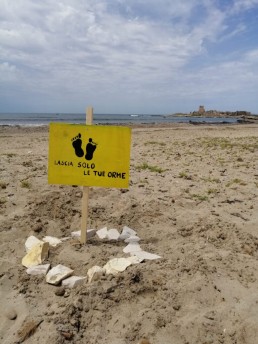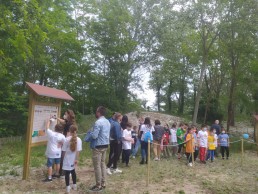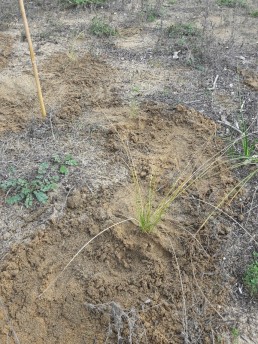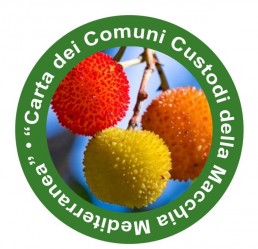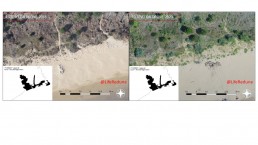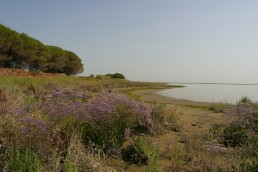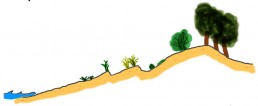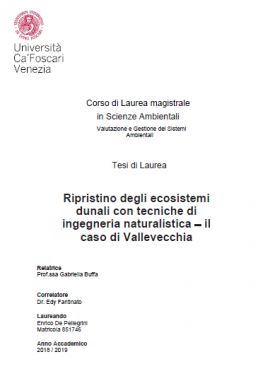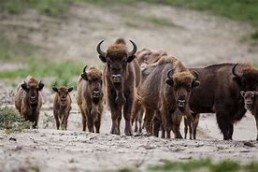(Bad) habits and sustainable tourism
Before the COVID pandemic, In Europe, the tourism industry produced almost 3.7% of EU GDP, with 1.8 million businesses and over 11.3 million jobs. If the allied industries are also taken into account, tourism-related sectors generated around 10% of EU GDP and 11% of the workforce (Eurostat 2018).
The question arises whether it is possible to generate this revenue without, therefore, creating a major impact on the environment.
Sustainability in the tourism sector is so important that the UN declared 2017 as the "International Year of Sustainable Tourism" and included the topic among the goals of the UN 2030 Agenda.
;
Of course, there are many ways to preserve the environment while on holiday and many of them are known and practised by many tourists, such as saving water and energy resources, not polluting, not encroaching on protected areas, respecting prohibitions, preferring local products, etc. etc.
But among the many small habits that we no longer pay attention to, which ones can we use to damage the environment, even unknowingly?
Thinking about the beach, the interface between water and land, how many of us behave in a sustainable manner? And who is aware of laws and regulations that they might break without ever having thought of them before?
Who does not like to pick up seashells while walking and keep them as a souvenir? And yet, shells are made up largely of calcium carbonate, a nutrient that is valuable to the ecosystem because it promotes the stability of the marine environment: it is a substrate for marine plants, acts as protection for algae and crabs and is a material for building birds' nests.
Who would not spend hours watching their dog frolicking on the free beach, perhaps at sunset? Unfortunately, dogs are one of the main causes of nest destruction and predation on the chicks of seabirds nesting in the sand, including the Common Red-backed Rock Thrush, an endangered and protected species under both national hunting and European biodiversity conservation legislation.
Who as a child did not catch a crab, a mollusc or a fish with a net and keep it in a bucket full of water and release it at night? Unfortunately, these little animals will meet a certain death as the temperature of the water in the bucket leads to irreversible damage. Article 544 of the Penal Code states that: "Anyone who cruelly or unnecessarily causes the death of an animal shall be punished by imprisonment from 4 months to 2 years".
;
Who wouldn't prefer to lie in the sun in the dunes, away from the crowds, and perhaps go exploring further into the pine forest, even if only for a bit of refreshment? Who ever thought that doing so might destroy rare plant species and valuable habitats? In fact, dune and backdune environments are part of the protected areas of the Natura 2000 network, an ecological network for the preservation of biodiversity. The Penal Code Art. 733-bis "Destruction or deterioration of habitats within a protected site" states that "Whoever, outside the permitted cases, destroys a habitat within a protected site or in any case deteriorates it, thus compromising its state of conservation, shall be punished with imprisonment of up to eighteen months and a fine of not less than 3,000 euros".
So, reflecting on our (bad) habits, are we sure that sustainable tourism is not easier to achieve than we might think?
The forgotten dune
Once upon a time there was a forgotten dune...
It was an old dune. Ancient maps show that there were "sand mountains" between Chioggia and Brondolo at the end of the 18th century, and until the 1960s the dunes were still present in the coastal area of what is now Sottomarina di Chioggia (VE).
Our dune had long resisted urbanisation, mass tourism, cultivated fields that were then left uncultivated... and as chance would have it, it had ended up in the garden of the Istituto Comprensivo Chioggia 5. Other, less fortunate, bumps of land attributed to the remains of the historic dunes had ended up in the green areas belonging to various local organisations: the civil protection headquarters, a residence for the elderly and a theatre centre.
One fine day, after a long time when the children had stopped going to school because of a terrible pandemic and when they were finally able to go back they had to stay outdoors as much as possible, the school headmistress remembered the old dune. The school already had a botanical garden and everyone had seen how much the children liked "doing to learn" and how much they learned by doing. So the idea was born to save the old dune from decay to create a beautiful botanical garden as a support for educational activities for the students.
The good headmistress called together teachers, professors and professors and together they devised a grandiose multidisciplinary project that included geography with the study of the climate and the territory, history with the collection of ancient documents and the testimonies of the old wise men of the village, art with the beautiful drawings of plants and flowers, and science with botany and the environment.
But all this was not enough to restore the old dune to its former glory.
So they called in the experts from Life Redune, a project financed by the European Community precisely to rehabilitate the habitats of the coastal dunes. Veneto Agricoltura intervened, analysing the old dune, its environmental context, exposure to wind and salt, and planned the necessary interventions.
First of all, the dune was cleaned of weeds and shrubs, thanks also to the parents and volunteers of "Amico Giardino", then it was raked and cared for until the 30 psammophyte seedlings, i.e. sand-lovers, born and raised at the Veneto Agricoltura Centro Biodiversità Vegetale e Fuori Foresta arrived. With love and patience, one by one the seedlings were removed from their pots and planted in the sand, according to the pre-established map to recreate the 2110-2120 habitat of the grey dunes. Each seedling has its place! Shrubs here in the sun, grasses there where there is some shade. The Ammophila arenaria at the top because it is the 'engineer of the dunes', holding the sand with its long rhizomes and catching the grains of sand with its thick tufts, carried by the wind as it falls on the dune and makes it rise. The more the sand accumulates, the bigger Ammofila becomes. Who knows what beautiful tufts it will display next summer!
But then who could explain all this to the parents? And who could give the teachers 'tips'? And who would answer the children's questions? The Cà Foscari University of Venice intervened, holding an environmental education meeting for adults and four meetings for pupils and students, divided into age groups. They presented the dunes, the many causes of threats to their habitats, the importance of dune ecosystems not only for biodiversity and the environment but also for protecting the coastline from erosion and flooding.
In order to protect the old dune, the Comprehensive Institute created a demarcated walkway so that everyone, young and old, could look at the dune, its flora, the small reptiles that hide there and the pollinating insects that visit it, without stepping on it. And to complete the work, three beautiful large information panels were put up to explain what the coastal dunes of the northern Adriatic are, how they are formed, what their habitats and flora are, and above all, how to behave when on the beach to preserve the dune environments.
And as in every good fairy tale with a happy ending, to celebrate the friendship between the old dune and the adults of tomorrow, a wonderful party was held where everyone was invited, but really everyone, because the dune of the Istituto Comprensivo Chioggia 5 is no longer just part of the history of the Sottomarina area but has become a part of the present for the citizens of today and the children of tomorrow.
Happy new life dear old dune!
And the sun was shining
On 22 April 2021, World Earth Day celebrations were held all over the world, the largest awareness-raising event for the protection of the planet, now in its 51st edition..
The creator of Earth Day was American activist John McConnell who proposed in 1969, during the San Francisco UNESCO Conference, a day to dedicate to the Earth to raise awareness of the need to preserve ecosystems and thus all forms of life on our planet.
This year the theme of World Earth Day was "restore your Earth" and who better than Life Redune to take the opportunity to restore a little piece of our land?
;
The Life Redune team invited its most active stakeholders to the naturalistic oasis of Vallevecchia, one of the project's intervention sites, for a day full of activities.
;
Ca' Foscari University, lead partner of the Life Redune project, welcomed the participants, presenting the project and its progress and showing live examples of dune habitats.
The project partner SELC coop. gave a concrete demonstration of the environmental engineering works by "reconstructing", in front of everyone's eyes, a dune profile using only sand from the sandy shore in front of the project and beached material to reinforce the foot of the dune. At the same time, informative and dissuasive signs were installed along the equipped paths of Vallevecchia in preparation for the next tourist-bathing season.
The Veneto Region, the project partner, presented to the representatives of the Participating Municipalities - Eraclea, San Michele al Tagliamento and Cavallino Treporti - the Conservation Measures of the Special Areas of Conservation (SAC) of the Natura 2000 Network to be integrated in the beach maintenance activities.
;
EPC srl, a project partner, has been able to reinforce its collaboration with the local associations with which it will continue to carry out environmental education activities in 2021: the Auxiliary Coast Guard of the Delta Tagliamento, Legambiente Veneto Orientale Circolo "Gerutto Pascutto" and the Comitato Foce del Tagliamento, as well as with the Carabinieri Forestali di Portogruaro who will ensure the monitoring of the project's intervention sites.
The tourist operators involved - Bibione Mare and Mete Beach - were able, together with the municipalities, to participate in monitoring the socio-economic impact of the project on the tourism sector and to organise the next environmental education trips to the dunes.
The presence of Dr. Lucio Panzarin of ISPRA gave the opportunity to talk about the protection of avifauna and in particular the conservation of the Kentish plover (Charadrius alexandrinus), which has returned to nest on the Veneto coast after years of absence.
The Centre for Plant and Forest Biodiversity of Veneto Agricoltura, a project partner, together with the staff of the Sistemazioni Idraulico Forestali (SIF) has planned the next autumn planting campaign for dune habitats.
Finally, at the end of the event, all participants were able to leave a video-testimony on their motivations for working with Life Redune and the meaning of the project for each of them.
Restocking Stipa veneta
Among the objectives of LIFE REDUNE is the strengthening (or restocking) of the populations of Stipa veneta* Moraldo present in the sites covered by the project. The aim is to increase the density of the existing populations through the planting of 1,000 conspecific individuals and to increase their genetic diversity in order to increase the viability of the populations themselves.
The action was planned on the basis of previous studies on the biological and ecological aspects of the species, causes and threat factors, as well as the physical characteristics of the sites involved and the processes underway.
Stipa veneta*, also known as the "Fairy Dublin", is the only species of Stipa in Europe that has adapted to live in maritime dune environments. The primary habitat of the species is the xerophilous backdune grasslands (grey dunes) of habitat 2130*. It is a very rare and endangered species, listed as a priority species in All. II (and IV) of Directive 92/43/EEC as well as on the IUCN Red List as Threatened (EN). The risk of extinction of the species is very high.
The threat factors linked to the biology of the species are combined with those linked to the habitat, which is subject to numerous pressures, both natural (evolution of the biocenosis) and anthropic (expansion of agriculture and human settlements; tourist infrastructures; trampling, etc.). The conservation status at national level (Continental Biogeographic Region) is defined as bad (U2), and presents negative trend (ISPRA, 194/2014).
The LIFE Redune Project foresees a series of coordinated actions and interventions dedicated to Stipa veneta* such as:
- "Plant nursery production" consisting in the collection of seeds from wild populations and the nursery production of the seedlings necessary for the implementation of the action to strengthen the populations of Stipa veneta*;
- "Strengthening of the populations of Stipa veneta*", which foresees the transplanting of Stipa veneta* in areas where small populations are now naturally existing along the coast of the northern Adriatic;
- "Monitoring of populations and plants of Stipa veneta*", which envisages the continuous control of introduced individuals and populations of the species at all project sites in both the ex-ante and ex-post phases.
With specific regard to the activities for strengthening the populations of Stipa veneta*, on 20 January 2020 the first planting of 500 Stipa veneta* plants took place within the "Laguna del Mort and Eraclea pinewoods" site. Prior to planting, the area underwent a thinning intervention within the 2130* - 2250* mosaic and an intervention to clean up the material beached following the events of the exceptional sea storm of 12 November 2019.
In the autumn period October-November 2020, the progress of activities related to the action of strengthening the population has provided for the planting of n. 42 seedlings of Stipa veneta* in the area of the Laguna del Mort (Municipality of Eraclea - VE ).
The seedlings were planted in small groups of 3-5 individuals at a distance of about 20/30 cm from each other. The single groups were spaced in different points of the habitat and made recognisable by the affixing of a bamboo cane with a marker.
The strengthening of the populations will continue during 2021 with the planting of an additional 500 individuals.
A network of stakeholders to protect the Mediterranean maquis
Networking among local stakeholders makes it possible to spread knowledge about the local environment, promote respect for it and, ultimately, protect it. This benefits biodiversity and ecological connectivity, but also the transmission of cultural values and territorial promotion.
Stakeholders in the area can be public administrations but also tourism operators, farms, promotion bodies, local associations and private citizens.
On the one hand, the LIFE REDUNE project is carrying out an action dedicated to the involvement of local stakeholders and, on the other hand, it is weaving a network with other projects in order to explore new opportunities for involvement and avoid the most common difficulties by sharing concrete experiences in other territories.
A good example comes from Sicily.
The Mediterranean Scrub is one of the most important ecosystems on the planet because, despite its modest territorial incidence (2%), it is home to 20% of animal and plant species. The scientific community recognises the Mediterranean scrub as a fundamental element in the fight against environmental pollution that must be protected precisely because of its exposure to significant risks such as fires and progressive desertification.
The initiative of the "Carta dei Comuni Custodi della Macchia Mediterranea" (www.cartamacchiamediterranea.it .) stems from the idea of networking among municipalities, which become "Custodians" of the Mediterranean scrub, committing themselves to elaborate, together with parks and associations, programmes for the protection of the rich naturalistic heritage present, above all, on the Sicilian territory.
The Charter of the Municipalities that are Custodians of the Mediterranean Scrub is therefore a "Pact of Honour" so that the Sicilian territorial and landscape specificities are valorised as well as an invitation to the Union of intents among the different Local Administrations.
On the occasion of the National Day of Trees 2020 also the Municipality of Graniti, the last in chronological order, has adhered to the Charter of the Municipalities that are custodians of the Mediterranean scrub. In fact, the Municipal Council chaired by Mayor Carmelo Lo Monte, with its resolution of 20 November 2020, gave a further strong signal in the direction of sustainability and enhancement of this important ecosystem.
This new adhesion will be a moment of beginning activities with actions of environmental education and sustainability both in the municipal territory, and in collaboration with the neighbouring municipalities that have already adhered and supported the Charter and with one of the associations supporting the project such as ASSOCEA Messina APS (www.ceamessina.it), which has a section and territorial offices in the Alcantara Valley (in Floresta, Castiglione di Sicilia and Giardini-Naxos).
Source: https://www.facebook.com/CartadeiComuniCustodidellaMacchiaMediterranea
Reducing anthropogenic impact on dune habitats
The aim of the LIFE REDUNE project is to guarantee the ecological functionality of the entire dune mosaic in four Natura 2000 sites through an ecosystem approach that considers all the components involved: human activities, habitats, species and physical processes.
The five intervention areas of the project are distributed along the stretch of Venetian coast between the municipalities of Chioggia and San Michele al Tagliamento: Bosco Nordio, Cavallino Treporti - Punta Sabbioni, Laguna del Mort and Pineta di Eraclea, Eraclea Mare, Vallevecchia, Punta Capalonga and Punta Tagliamento.
LIFE REDUNE interventions for the reduction of anthropic impact on habitats aim at facilitating the recovery of the integrity of habitats and species populations in the project areas through the removal or reduction of both ecological and landscape impacts generated by transit and uncontrolled frequentation of the dune system for tourism purposes.
As an indicator of anthropic disturbance, the extension of the surface of unauthorised paths present in the project areas was chosen. The expected result of the LIFE REDUNE interventions was a decrease in the phenomenon of footpaths due to better regulation of access flows to the sea.
;
After an initial monitoring carried out to provide objective pre-intervention data, two years later the 2020 monitoring activity allowed the morphological, ecological and dynamic characterisation of the five project areas following the implementation of the requalification interventions. In particular, it was possible to verify the effectiveness of the interventions in reducing the anthropic impact on the habitats, through the detailed mapping of the minor access routes to the beach (paths) and the areas with the highest tourist load.
In order to obtain comparable data, the methodology used for the in itinere monitoring in 2020 was the same as that used in the ex ante phase in 2018.
The monitoring action began with an aerial photogrammetric survey, carried out using a Remotely Piloted Aircraft System, equipped with a compact camera that takes photographs according to a previously planned grid and communicates with the ground station via a radio signal. The flights were carried out at an altitude of 145 metres above the ground. A total of 316.6 hectares were flown over and 3,631 were taken, with an accuracy of the order of centimetres and a frame resolution of 5 cm pixels on the ground.
The GPS survey made it possible to have a number of control points which were used, during data processing, to correct the georeferencing of the three-dimensional model and the photo-plans produced by aerial photogrammetry. As far as the absolute position of each object is concerned, the maximum deviation can be 15 cm, while for the reciprocal distances the accuracy can go up to 5 cm, limited more than anything else by the resolution of the image.
Apart from special cases, such as the presence of water, dense vegetation or very tall trees, the digital model faithfully shows the shape of the bare ground, buildings, tree and shrub tops, shrubs and very dense herbaceous species..
;
From the analysis of the data, path demarcation is confirmed to be a very effective action to limit anthropogenic disturbance. The most evident effects can be seen at the Punta Capalonga site, where the area has been reduced by about 65%. They are reduced to approximately -9% at the Vallevecchia site and completely disappear at the Laguna del Mort site.
Although it is not evident from the data reported, this decreasing trend in the effectiveness of the interventions is at least partly attributable to the different control and monitoring regime of the three areas, which has an inverse trend. The Capalonga site is a relatively small area, facing a campsite, whose managers promptly joined the project and actively collaborated in the monitoring of the area and in the education and communication activities provided by the project. In the other two cases, we are dealing with large stretches of free beach, partially guarded in the case of the Vallevecchia site, and poorly guarded in the case of the Laguna del Mort site, where numerous acts of vandalism to the information panels and walkways and fences positioned by LIFE REDUNE also occurred.
Environmental rehabilitation and enhancement in Valle Vecchia
Valle Vecchia is the only undeveloped stretch of north Adriatic coastline. Valle Vecchia is not a park, but something more!
The lagoon oasis of Valle Vecchia, between the Tagliamento and Livenza rivers, represents a typical situation of the Veneto coastal environment. It is characterised by over 4 kilometres of sandy coastline and an agrarian hinterland obtained by reclaiming the pre-existing brackish lagoon areas. The soils are sandy and clayey, with frequent infiltration of brackish water.
In Valle Vecchia, large areas of lagoons and bodies of water preserve the characteristics of the ancient layout of the territory as it was before the land reclamation in the 1960s. It is precisely because of its environmental characteristics and the presence of habitats such as the sand dunes and the woods behind them, which host exceptional biodiversity in a restricted area, that Valle Vecchia has been recognised as a Special Protection Area and Special Area of Conservation in the European Community's Natura 2000 Network.
Today, out of a total of over 800 hectares, almost half are occupied by areas of great naturalistic value: 63 hectares of coastal pine forest, 100 hectares of coastal lowland woods, 68 hectares of wetlands and approximately 24 km of hedges.
Between the sandy shore and the pine forest there is one of the largest coastal dune systems in the Veneto region, which is being redeveloped as part of the LIFE REDUNE Project.
Due to its environmental value, Valle Vecchia, already popular with beach tourism due to its long sandy coastline free of establishments, is also a destination for nature, educational and scientific tourism.
Numerous well-equipped paths, which can be followed on foot, by bicycle or on horseback, allow visitors to appreciate an area rich in valuable habitats and to discover how innovation, research and experimentation in agriculture, the environment and biodiversity coexist and complement each other.
Valle Vecchia is not only beach and sea, in factit is home to one of the most important regional farms managed by the Agenzia veneta per l'innovazione in agricoltura Veneto Agricoltura. A farm devoted entirely to experimentation and demonstration of the most advanced agricultural techniques with low environmental impact. Valle Vecchia practises an agriculture capable of combining income, quality and respect for the environment.
Agriculture is an important part of the environmental mosaic, since the fields and cultivated areas surrounded by woods and hedges are an ideal place for resting, grazing and living for wildlife.
The alternation of cultivated areas, woodlands and fresh and salty wetlands, which characterises the landscape of this farm, favours biodiversity. There are numerous animal species. In particular, birds, of which there are more than 250 species, i.e. almost 50% of those found in Italy. Mammals include badgers, foxes, stone martens, weasels, roe deer, fallow deer, squirrels and various species of bats. There are many insects, especially lepidopterans, with some very rare and endemic species.
In this area of regional property, over a period of about twenty years, numerous European agricultural, forestry and environmental research projects have been implemented, enabling the creation of one of the most important Italian examples of environmental redevelopment and enhancement..
Sources:
http://www.caorle.com/it/caorle/brussa-vallevecchia.html
Equestrian map of Vallevecchia - Veneto Agricoltura
Acknowledgements:for the text Dott.ssa Giovanna Bullo - Veneto Agricoltura
for the photo: Dr. Sandrino Colavitti - Veneto Agricoltura
Plant biodiversity and adaptation to the environment on coastal dunes
Beaches and sand dunes impose extreme conditions on plants that are at the limit of their survival: the constant wind carries salt droplets that encrust them and sand that continually grinds and submerges them, the substrate does not retain moisture and can reach temperatures of 60 °C. Only psammophytes, or sand plants, can survive in these conditions, thanks to special adaptations.
Only psammophytes, or sand plants, can survive in these conditions, thanks to special adaptations.
To protect themselves from the wind, many species are small or grow on the ground, such as fumana (Fumana procumbens). To find and store what little water is available, the maritime vilucchio (Convolvulus soldanella) and the ravastile (Cakile maritima) have deep roots and fleshy leaves where they store water, like desert cacti. To protect itself from the high temperatures, marine alfalfa (Medicago marina) covers itself with a felt of hairs. Species such as sea holly (Eryngium maritimum), juniper (Juniperus communis) and holm oak (Quercus ilex) have stiff, leathery leaves covered with waxes to limit water loss.
Other plants have adapted to being submerged in sand: the prickly sparto (Ammophila arenaria) develops underground stems (rhizomes) whose growth is stimulated by submergence. Thanks to its rhizomes, this species traps grains of sand and allows dunes to form: it is the true "dune engineer".
It is the true "dune engineer";
Beaches and dunes generate and evolve thanks to the balance between the sea currents, which deposit the sand on the beach, the sun, which dries the sand, the wind, which carries it inland, and the plants, which trap it.
The plants that grow on the dune, as well as actively contributing to its construction, as the dune grows, form different communities arranged in bands (zones) parallel to the coastline, along the strong environmental gradients, to form the so-called coastal zoning.
The community closest to the sea is called Cakileto, named after the guide species Cakile maritima. Although small, the plants of the Cakileto dampen the action of the wind and allow the formation of the first accumulations of sand, the 'embryonic dunes'. It is here that the first perennial plants, such as Elymus farctus, grow, triggering the process of dune formation. Behind the Elymus farctus, the "mobile dunes" develop, colonised by Ammophila arenaria, a species that is very resistant to wind and silting up, whose tufts favour the accumulation of sand and react to silting up by growing in height, thus allowing the dune to grow. Behind the Ammofileto there is a protected zone, the "grey dunes".
The protection from the wind and saltiness allows the presence of more species and the formation of a prairie with flowering species, mosses and lichens, the Tortulo-Scabioseto.
The vegetation of the sandy shores reaches its most complex form in the 'fixed dunes'. The more sheltered conditions allow the development of shrub communities, often dominated by the common juniper (Juniperus communis). The Juniper wood consolidates the dune and creates the conditions for the development of the coastal wood, the Lecceta, dominated by Quercus ilex. The coastal woodland has become rare and has often been replaced by reforestation with Mediterranean pines (Pinus pinea, P. pinaster).
The effectiveness of mobile dune restoration work at the Vallevecchia site
Dune ecosystems are increasingly threatened by human disturbance and pressure. This causes an alteration of the plant communities and of the balances that regulate the formation of coastal dunes.
The plant component of coastal ecosystems ensures the growth and continuous development of the dune; however, it is the component of dune ecosystems that is most affected by human disturbance. The lack of vegetation caused by disturbance triggers erosion processes that impoverish the structure and functionality of the entire ecosystem.
In view of the increasing loss of surface area and the degradation of the remaining areas, ecological restoration measures are an ideal solution for safeguarding the biodiversity of coastal ecosystems. Restoration measures are generally concentrated where anthropogenic pressure has been excessive and the conservation status of the ecosystem is compromised.
;
The research work that led to the thesis entitled "Restoration of dune ecosystems using naturalistic engineering techniques - the case of Vallevecchia" made it possible to assess the effectiveness of the restoration work carried out by the LIFE REDUNE project at the Vallevecchia (Caorle) site.
In particular, the restoration of the mobile dunes, as an essential component of coastal ecosystems, was carried out in 5 phases: physical reconstruction of the dune profile, stabilization, planting of nuclei of vegetation proper to the habitat, creation of new accesses to the beach with restrictions and signs, monitoring.
Transplanting took place in November 2018; afterwards, the plantings were monitored using the permanent plot technique. Squares of vegetation of 1m by 1m are monitored periodically to assess the survival of the transplanted species and the evolution of the habitat.
Initial analyses identified two distinct groups of plots: plots located in undisturbed neo-dunes and plots located in disturbed neo-dunes (despite the precautionary measures taken at the beginning of the project). The disturbance, due to the large number of tourists at this site and the lack of respect for the rules, has caused plants to fail to take root in some areas of the restoration, with the consequent loss of biodiversity. On the contrary, in the undisturbed areas most of the transplanted species took root, demonstrating strong vitality, given by a remarkable growth of the individuals in terms of height, new shoots or leaves and cover..
Moreover, following the restoration work, and in the absence of disturbance, it was possible to observe the appearance of other species which in turn developed considerably. At the beginning of the project, only four species were recorded, but by the end of the project, 12 species had been monitored. This demonstrates the effectiveness of the restoration work. However, it is very important that the work is not affected by disturbance events, which would nullify the whole goodness of the project and the survival of the ecosystem.
Dune ecosystems are among the most ecologically and scenically important in the world and therefore need to be safeguarded..
;
References:
"Restoration of dune ecosystems with naturalistic engineering techniques - the case of Vallevecchia" Enrico De Pellegrini, Master thesis in Environmental Sciences, University Cà Foscari Venice
Reconstructing the Dutch dunes with the European bison
The Zuid-Kennemerland National Park is now the coastal dune area that is home to the bison in the north of the Netherlands..
Until a few years ago, the Zuid-Kennemerland National Park was largely open to the public, with the exception of an area to the south that was kept closed. The closed area was a dynamic dune system, but in the absence of large herbivores and people, the dunes were becoming increasingly vegetated. The vegetation prevented the sand from moving and the dynamic dunes were made sedentary. This triggered the idea of bringing in large herbivores to remove the vegetation and allow the dunes to move freely again.
The European Bison in a Dutch Dune System project (https://rewildingeurope.com/rew-project/european-bison-in-a-dutch-dune-system/) started in 2007 as part of the Rewilding Europe projects (https: // rewildingeurope.com), a pan-European initiative working at the forefront of recreating natural habitats on a European scale.
The pilot project consisted of returning the European bison to an area in Western Europe where it could live naturally (i.e. without additional food supply), together with Konik horses, Highland cattle, fallow deer, roe deer and rabbits, which were already species of animals used for natural grazing throughout the Netherlands.
The project was carried out in an area of coastal dunes where forested areas are intertwined with open grassland and shrubland. The habitat types are semi-open grassland, shrubland, broadleaf and coniferous forests.
But why bison?
The rewilding initiative aims to rehabilitate nature: restoring ecosystems and their food chains. European bison are known as keystone species of habitats that engineer great biodiversity.
Noting the invasion of non-native vegetation, the decline of a common food source has been blamed: specialised insects that need patches of open sand to survive. Bison clean the area, scrub the ground, and with this behaviour, throughout the year, create several local sand patches where native pioneer vegetation and insects once again have a chance to proliferate. Dune birds such as the eagle owl, golden oriole and red-backed shrike that were heading for local extinction have now returned.
Since they also bark shrubs and trees and encourage the dispersal of native grasses through their manure, the bison are essentially bringing back the original biodiversity.
The area of the Zuid-Kennemerland National Park where the bison now live is the 330 hectare area that was closed to the public in the past. Now, the area is open to the public, with a footpath that runs through the bison enclosure and is open in the winter months, so tourists can walk and hopefully catch a glimpse of these majestic creatures among the rolling hills and dunes.
The European bison is one of two living species of bison, the other being the North American bison. Established in the wild in the 1920s, the European bison has returned thanks to conservation programmes across the continent, from a herd of 12 animals kept in captivity. The European bison is one of the two living species of bison.
The European bison in a Dutch dune system project, which officially ended in 2012, provided valuable practical and scientific knowledge on the ecological aspects of bison such as diet composition and habitat use, including in comparison to cattle and horses. It also attracted the attention of the press, which in turn informed the public about the species and promoted the Zuid-Kennemerland National Park as a tourist attraction for nature tourists.
Particularly important for European bison conservation programmes is the expansion of the bison area and the natural growth of the herd.
A series of research articles from the Dutch study of a herd of 22 bison living in Kraansvlak, in the 330 hectares of natural dunes and ponds that are part of the Zuid-Kennemerland National Park, further casts doubt on the belief that European bison are forest-dwelling creatures, now offering a more optimistic assessment of the bison's chances of survival in new European environments.
In 2016, two more Dutch bison introduction sites followed the project, after gaining experience in Kraansvlak.
Nature organisations in Sweden, Switzerland and the UK are watching with interest and the knowledge gained is being shared with established projects in Spain, France and Germany.
E se il prossimo passo per la riqualificazione auto-sostenibile dei siti dunali di LIFE REDUNE contemplasse anche la creazione di parchi naturali popolati dai bisonti Europei?
Riferimenti:
PROGETTO Bisonti europei in un sistema dunale olandese: https://rewildingeurope.com/rew-project/european-bison-in-a-dutch-dune-system/
https://forpeoplefornature.com/2015/08/07/introducing-bison-in-the-dutch-dunes/



